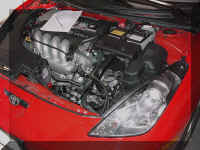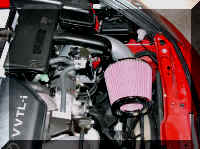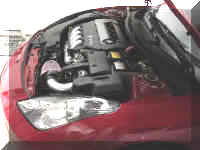Home of The Shuttle...
Home The Cars The Humor Contact Me
Visitor Number
|
Welcome
to
TurboCelica.com.. Home of The Shuttle... |
Navigation
Menu Home The Cars The Humor Contact Me |
Visitor Number |
My 2000 Toyota Celica GT-S Mods - Rod Millen Intake and Exhaust
The Problem:
Stock (restrictive) Intake and Exhaust systems
The Solution: Rod Millen's Intake and Exhaust
components
Cost: $740, and a couple hours of my own labor.
Summary: A most excellent modification to the otherwise stock engine and drive-train. The before and after dyno run indicates an increase of 9 hp at the front wheels. This combination starts making usable power even before the vvtL-i engagement at 6000 rpms, at which point, the driver needs to be ready to steer and shift quickly. From 6000 rpms to redline, this baby chews-up the road in short order.
Update - August 28, 2001. Over the past several months, I had noticed a gradual degradation in performance. I didn't know what to make of it, and due to my work schedule, I had no time to investigate the issue. However, I most recently began noticing an occasional yet significant loss of power in the 5K - 6K range. The engine will seem to fall flat for a few hundred rpm, then pull strong again. Additionally, I also noted a less dramatic surge in power at 6000 rpms as the high rpm cams engage. The car has 41K miles and is 2 months shy of it's 2nd b-day. Long story short, I take it to my dealership, Gullo Toyota, and they find that oil from the Rod Millen-supplied K&N filter has gooped-up the Mass Air Flow sensor (MAF). They clean it, and now the car once again runs like the wild cheetah that it is. Net-Net: If you have or plan to buy a RMM intake, you may want to occasionally check your MAF for oily build-up.
The Intake
|
Before |
After |
 |

 |
Issues to note:
1. The first issue involves the fitment of the mass air-flow sensor (MAF) to the mounting boss on the large U-shaped intake pipe which comes with the RMM intake. It looked to me that the MAF mounting boss was about .5 mm too high, thus causing the MAF o-ring to not sink into the bore. I saw this as potential sealing problem, so, I filed down the boss just enough to ensure the o-ring was recessed rather than at the bore's edge.
2. The second issue is with the female threads used to attach the MAF. The screws supplied with the kit were very tight when screwed-in for the first time. I presume the thermal coating applied to the tube had infiltrated into the threads causing the bind. These are small #4 screws, and they could easily break-off if the installer is not careful. So, lacking a #4 machine tap, and without the MAF, I lubricated the threads of both the screws and mounting boss female threads with LPS2, and with a back-and-forth action typically used with a tap or die, I carefully threaded the screws into each hole until the screw was all the way in. I then removed each screw and affixed the MAF as per the RMM instructions. I mention both of these items only because the typical non-mechanically-inclined person will likely not catch these issues and possibly end up with a leaky MAF and/or a broken screw.
| The Exhaust | |
| There's really not much to say about the exhaust. Removing the stock exhaust took every bit of 10 minutes with installation of the RMM exhaust requiring about 20 minutes, and that was because I took time to snap a photo or two. |
The
Results
The sound of this engine only
gets better with these Rod Millen parts. They impart a
very throaty note from the intake and low burble from the
exhaust - a far cry from the pissed-off bumble-bee-like
sound from the typical Civic/Integra with a big muffler.
Idling at a stop light, it's very difficult to perceive a
difference from stock. But tap the throttle or get
this baby whizzing above 5000 rpms, and all bets are off.
All the way to redline, these parts make for some beautiful
sounds.
BOY does the sound of the engine switch from
“docile little 4 cylinder”
to
“I’m a raging terror"
when the VVTL-I kicks in at about 6000 rpms.
Hondaweenies beware!
|
|
Return to the 2000 Celica GT-S Mods page |